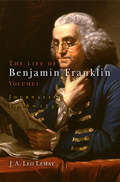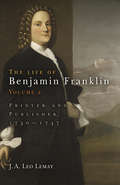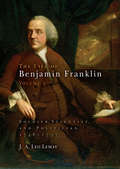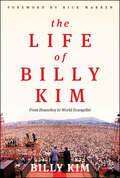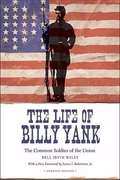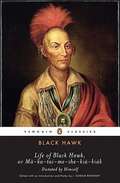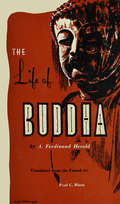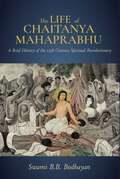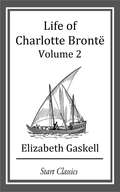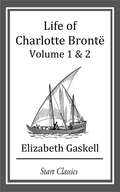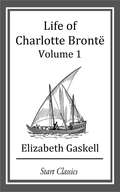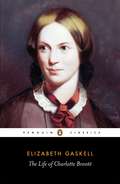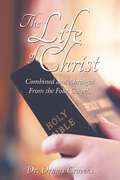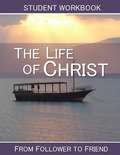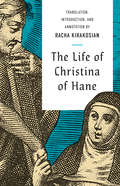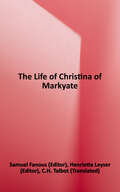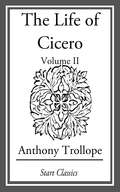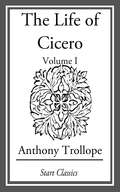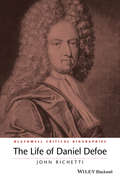- Table View
- List View
The Life of Benjamin Franklin, Volume 1
by J. A. Leo LemayNamed "one of the best books of 2006" by The New York SunDescribed by Carl Van Doren as "a harmonious human multitude," Benjamin Franklin was the most famous American of his time, of perhaps any time. His life and careers were so varied and successful that he remains, even today, the epitome of the self-made man. Born into a humble tradesman's family, this adaptable genius rose to become an architect of the world's first democracy, a leading light in Enlightenment science, and a major creator of what has come to be known as the American character. Journalist, musician, politician, scientist, humorist, inventor, civic leader, printer, writer, publisher, businessman, founding father, and philosopher, Franklin is a touchstone for America's egalitarianism.The first volume traces young Franklin's life to his marriage in 1730. It traces the New England religious, political, and cultural contexts, exploring previously unknown influences on his philosophy and writing, and attributing new writings to him. After his move to Philadelphia, made famous in his Autobiography, Franklin became the Water American in London in 1725, where he was welcomed into that city's circle of freethinkers. Upon his return to the colonies, the sociable Franklin created a group of young friends, the Junto, devoted to self-improvement and philanthropy. He also started his own press and began to edit and publish the Pennsylvania Gazette, which became the most popular American paper of its day and the first to consistently feature American news.
The Life of Benjamin Franklin, Volume 2
by J. A. Leo LemayNamed "one of the best books of 2006" by The New York SunDescribed by Carl Van Doren as "a harmonious human multitude," Benjamin Franklin was the most famous American of his time, of perhaps any time. His life and careers were so varied and successful that he remains, even today, the epitome of the self-made man. Born into a humble tradesman's family, this adaptable genius rose to become an architect of the world's first democracy, a leading light in Enlightenment science, and a major creator of what has come to be known as the American character. Journalist, musician, politician, scientist, humorist, inventor, civic leader, printer, writer, publisher, businessman, founding father, philosopher, Franklin is a touchstone for America's egalitarianism.Volume 2 takes Franklin from his marriage in 1730 to his retirement as a printer at the beginning of 1748, examining the mysteries of the illegitimate William Franklin's birth and mother and Franklin's increasing civic activities--starting the Library Company in Philadelphia in 1731, forming Pennsylvania's first volunteer fire company, and becoming an advocate for a clean Philadelphia environment. J. A. Leo Lemay assesses Franklin's numerous writings, attributing to him for the first time a deistic Indian speech, remarking on his use of the second African American persona in journalism, and analyzing his publishing sensation of 1747, The Speech of Miss Polly Baker. These belletristic works are complemented by Franklin's religious, political, and scientific writings, which he produced prodigiously.
The Life of Benjamin Franklin, Volume 3
by J. A. LemayDescribed as "a harmonious human multitude," Ben Franklin's life and careers were so varied and successful that he remains, even today, the epitome of the self-made man. Born into a humble tradesman's family, this adaptable genius rose to become an architect of the world's first democracy, a leading light in Enlightenment science, and a major creator of what has come to be known as the American character. Journalist, musician, politician, scientist, humorist, inventor, civic leader, printer, writer, publisher, businessman, founding father, philosopher--a genius in all fields and a bit of a magician in some.Volume 3 begins in the year 1748, when Franklin was known in Pennsylvania as clerk of the Pennsylvania Assembly and in the Middle Colonies as the printer and editor of Poor Richard's Almanac and the Pennsylvania Gazette, the best-known colonial publications. By the middle of 1757, where this volume leaves off, he had become famous in Pennsylvania as a public-spirited citizen and soldier in the conflicts of the Seven Years' War; well known throughout America as a writer, politician, and the most important theorist and patriot of the American empire; and renowned in the western world as a natural philosopher. This volume tells the story of that transformation.
The Life of Billy Kim: From Houseboy to World Evangelist
by Billy KimWhen a man meets a man, history happens.When a man meets God, miracles happen.Billy Kim was plucked out of poverty and obscurity during wartime in Korea by what could only have been chance—or a miracle. Picked seemingly at random by an American GI to be the houseboy for their barracks in Korea, sixteen-year-old Billy began the path that would bring him to school in America. Later he would go on to be the translator for Billy Graham&’s 1973 crusade, a preacher to millions, and an influential global leader for the spread of the gospel. He has been aptly described as the Billy Graham of Asia. The Life of Billy Kim is the story of how God&’s work has been revealed in this one man&’s life. For anyone looking for guidance as they serve the Lord, Billy Kim&’s life will be a powerful inspiration of providence in a surrendered life. This is the story of what God can do through the life of a person extraordinarily surrendered to His will.
The Life of Billy Kim: From Houseboy to World Evangelist
by Billy KimWhen a man meets a man, history happens.When a man meets God, miracles happen.Billy Kim was plucked out of poverty and obscurity during wartime in Korea by what could only have been chance—or a miracle. Picked seemingly at random by an American GI to be the houseboy for their barracks in Korea, sixteen-year-old Billy began the path that would bring him to school in America. Later he would go on to be the translator for Billy Graham&’s 1973 crusade, a preacher to millions, and an influential global leader for the spread of the gospel. He has been aptly described as the Billy Graham of Asia. The Life of Billy Kim is the story of how God&’s work has been revealed in this one man&’s life. For anyone looking for guidance as they serve the Lord, Billy Kim&’s life will be a powerful inspiration of providence in a surrendered life. This is the story of what God can do through the life of a person extraordinarily surrendered to His will.
The Life of Billy Yank: The Common Soldier of the Union
by Bell Irvin WileyIn this companion to The Life of Johnny Reb, Bell Irvin Wiley explores the daily lives of the men in blue who fought to save the Union. With the help of many soldiers' letters and diaries, Wiley explains who these men were and why they fought, how they reacted to combat and the strain of prolonged conflict, and what they thought about the land and the people of Dixie. This fascinating social history reveals that while the Yanks and the Rebs fought for very different causes, the men on both sides were very much the same.
Life of Black Hawk, or Ma-ka-tai-me-she-kia-kiak
by Black HawkA controversial figure in his day, Black Hawk was the leader of the Sauk American Indian tribe in the early 1800s. The son of the tribe s medicine man, Black Hawk s exploits as a warrior aided his rise to the status of tribal war leader. Here, Black Hawk chronicles his life as well as the story of his tribe, who were forced from their lands in Illinois during a series of skirmishes with American settlers in what came to be known as the Black Hawk War.
The Life of Buddha
by Paul C. Blum A. Ferdinand HeroldTHE LIFE OF BUDDHA Based on prolonged study of Indian legends, poems,history) and literature, The Life of Buddha not only adds to the actual knowledge of the facts surrounding the life of the Lord Buddha, but it also renders intelligible much that has hitherto mystified the Western student of the Orient. With great clarity, the author brings out the modes of life the sense of values, the technique of meditation, and the daily life of the Lord Buddha. This book should have appeal to a great variety of readers; packed with stimulating information, it is of interest to the student of Eastern religion and mysticism and the lover of Asiatic art, as well as to those concerned with philosophy, with the psychology of religion, and also to the general reader who hopes to gain an insight into the Orient. This vivid account of Buddha's life shows clearly how the values and manners set down by this man swept through India, Burma, Indo-China, and Ceylon, across China and Korea, and into Japan; and howthe daily life of a man who lived over two thousand five hundred years ago has become an inspiration, not only to millions of Chinese, Koreans, and Japanese,but also to increasing numbers of Westerners as well.
The Life of Chaitanya Mahaprabhu: Sri Chaitanya Lilamrita
by Swami B. BodhayanThe Life of Chaitanya Mahaprabhu offers a brief history of the 15th century Vedic spiritual revolutionary, Chaitanya Mahaprabhu, who expounded Bhakti yoga, popularized the chanting of Hare Krishna, and is an incarnation of Lord Krishna.In this abridged biography of Chaitanya Mahaprabhu, Swami B. B. Bodhayan informs how Sri Krsna appeared in the form of Lord Chaitanya to deliver all fallen souls by distributing His love without discrimination. He taught his devotees how to surrender by His own example and how surrender is the soul of devotional practice. Many scriptures describe Lord Chaitanya as non-different from Lord Krsna; although Lord Chaitanya is Krsna Himself, He took the role of being His own devotee to deliver the people of the world. To spread the chanting of the holy name of the Supreme Lord, which will ultimately give us the taste of divine love, Lord Chaitanya took the renounced order (sannyasa). Thus, He gave the order to everyone to spread His name: Hare Krsna Hare Krsna Krsna Krsna Hare Hare Hare Rama Hare Rama Rama Rama Hare Hare. We have seen Lord Chaitanya, Himself, preach and inspire people to chant the Hare Krsna mahamantra. But personally, He did not give initiation. He also did not establish any temples. He taught us to spread sankirtana without having any ulterior motives. Our spiritual lineage all follow in the footsteps of Lord Chaitanya. If anyone follows the principle of &“first preserve then propagate,&” then one shall definitely be delivered from this material world.
Life of Charlotte Bronte
by Elizabeth GaskellElizabeth Gaskell's The Life of Charlotte Brontë (1857) is a pioneering biography of one great Victorian woman novelist by another. Gaskell was a friend of Charlotte Brontë, and, having been invited to write the official life, determined both to tell the truth and to honour her friend. She contacted those who had known Charlotte and travelled extensively in England and Belgium to gather material. She wrote from a vivid accumulation of letters, interviews, and observation, establishing the details of Charlotte's life and recreating her background. Through an often difficult and demanding process, Gaskell created a vital sense of a life hidden from the world. This edition is based on the Third Edition of 1857, revised by Gaskell. It has been collated with the manuscript, and the previous two editions, as well as with Charlotte Brontë's letters, and thus offers fuller information about the process of composition than any previous edition.
Life of Charlotte Bronte
by Elizabeth GaskellElizabeth Gaskell's The Life of Charlotte Brontë (1857) is a pioneering biography of one great Victorian woman novelist by another. Gaskell was a friend of Charlotte Brontë, and, having been invited to write the official life, determined both to tell the truth and to honour her friend. She contacted those who had known Charlotte and travelled extensively in England and Belgium to gather material. She wrote from a vivid accumulation of letters, interviews, and observation, establishing the details of Charlotte's life and recreating her background. Through an often difficult and demanding process, Gaskell created a vital sense of a life hidden from the world. This edition is based on the Third Edition of 1857, revised by Gaskell. It has been collated with the manuscript, and the previous two editions, as well as with Charlotte Brontë's letters, and thus offers fuller information about the process of composition than any previous edition.
Life of Charlotte Bronte
by Elizabeth GaskellElizabeth Gaskell's The Life of Charlotte Brontë (1857) is a pioneering biography of one great Victorian woman novelist by another. Gaskell was a friend of Charlotte Brontë, and, having been invited to write the official life, determined both to tell the truth and to honour her friend. She contacted those who had known Charlotte and travelled extensively in England and Belgium to gather material. She wrote from a vivid accumulation of letters, interviews, and observation, establishing the details of Charlotte's life and recreating her background. Through an often difficult and demanding process, Gaskell created a vital sense of a life hidden from the world. This edition is based on the Third Edition of 1857, revised by Gaskell. It has been collated with the manuscript, and the previous two editions, as well as with Charlotte Brontë's letters, and thus offers fuller information about the process of composition than any previous edition.
The Life of Charlotte Bronte
by Elizabeth GaskellElizabeth Gaskell's biography of her close friend Charlotte Brontë was published in 1857 to immediate popular acclaim, and remains the most significant study of the enigmatic author who gave Jane Eyre the subtitle An Autobiography. It recounts Charlotte Brontë's life from her isolated childhood, through her years as a writer who had 'foreseen the single life' for herself, to her marriage at thirty-eight and death less than a year later. The resulting work - the first full-length biography of a woman novelist by a woman novelist - explored the nature of Charlotte's genius and almost single-handedly created the Brontë myth.
The Life of Christ: Combined and Abridged From the Four Gospels
by Dennis CravensRead the entire story of Christ’s life in one flowing easy to read narrative based solely on the verses in four gospels and with references to those biblical verses.
Life of Christ: Invited to Love, Student Workbook
by Wheaton PressThis workbook coincides with the Life of Christ 301 Class: Becoming a friend of Jesus. Students will examine the Life of Christ to gain a more full perspective and understanding on the person and work of Jesus Christ.
The Life of Christina of Hane
by Christina of HaneThe first English translation of The Life of Christina of Hane, a gripping account of a largely unknown medieval female mystic&“Who was Christina of Hane? History knows little about her, but Racha Kirakosian here presents a fascinating enigma—a mystical compendium disguised as a saint&’s Life. Students of medieval religion will eagerly probe its mysteries.&”—Barbara Newman, Northwestern University The thirteenth-century mystic Christina of Hane led an extraordinary life, but her recently unearthed case remains to be discovered in the English-speaking world. Her disturbing account of vaginal mutilation, her competition with the Virgin Mary, and her potentially heretical statements about the union with Christ are but a few peculiarities worth highlighting. This remarkable work sheds new light on convent life, spiritual practices, and physical and mental suffering in the life of medieval women and the communities they inhabited.
The Life of Christina of Markyate (Oxford World's Classics)
by C. H. Talbot"I wish to remain single, for I have made a vow of virginity." This is the remarkable story of the twelfth-century recluse Christina, who became prioress of Markyate, near St Albans in Hertfordshire. <p><p>Determined to devote her life to God and to remain a virgin, Christina repulses the sexual advances of the bishop of Durham. In revenge, he arranges her betrothal to a young nobleman but Christina steadfastly refuses to consummate the marriage and defies her parents' cruel coercion. <p><p>Sustained by visions, she finds refuge with the hermit Roger, and lives concealed at Markyate for four years, enduring terrible physical and emotional torment. Although Christina is supported by the abbot of St Albans, she never achieves the recognition that he intended for her. <p><p>Written with striking candor by Christina's anonymous biographer, the vividness and compelling detail of this account make it a social document as much as a religious one. Christina's trials of the flesh and spirit exist against a backdrop of scheming corruption and all-too-human greed.
The Life of Cicero: Volume II
by Anthony Trollope>Anthony Trollope (1815-1882) was one of the most successful, prolific and respected English novelists of the Victorian era. He wrote penetrating novels on political, social, and gender issues and conflicts of his day. In 1867 Trollope left his position in the British Post Office to run for Parliament as a Liberal candidate in 1868. After he lost, he concentrated entirely on his literary career. While continuing to produce novels rapidly, he also edited the St Paul's Magazine, which published several of his novels in serial form. His first major success came with The Warden (1855) - the first of six novels set in the fictional county of Barsetshire. The comic masterpiece Barchester Towers (1857) has probably become the best-known of these. Trollope's popularity and critical success diminished in his later years, but he continued to write prolifically, and some of his later novels have acquired a good reputation. In particular, critics generally acknowledge the sweeping satire The Way We Live Now (1875) as his masterpiece. In all, Trollope wrote forty-seven novels, as well as dozens of short stories and a few books on travel.
The Life of Cicero: Volume I
by Anthony TrollopeAnthony Trollope (1815-1882) was one of the most successful, prolific and respected English novelists of the Victorian era. He wrote penetrating novels on political, social, and gender issues and conflicts of his day. In 1867 Trollope left his position in the British Post Office to run for Parliament as a Liberal candidate in 1868. After he lost, he concentrated entirely on his literary career. While continuing to produce novels rapidly, he also edited the St Paul's Magazine, which published several of his novels in serial form. His first major success came with The Warden (1855) - the first of six novels set in the fictional county of Barsetshire. The comic masterpiece Barchester Towers (1857) has probably become the best-known of these. Trollope's popularity and critical success diminished in his later years, but he continued to write prolifically, and some of his later novels have acquired a good reputation. In particular, critics generally acknowledge the sweeping satire The Way We Live Now (1875) as his masterpiece. In all, Trollope wrote forty-seven novels, as well as dozens of short stories and a few books on travel.
The Life of Daniel Defoe: A Critical Biography (Wiley Blackwell Critical Biographies #7)
by John RichettiThe Life of Daniel Defoe examines the entire range of Defoe’s writing in the context of what is known about his life and opinions. Features extended and detailed commentaries on Defoe’s political, religious, moral, and economic journalism, as well as on all of his narrative fictions, including Robinson Crusoe Places emphasis on Defoe’s distinctive style and rhetoric Situates his work within the precise historical circumstances of the eighteenth-century in which Defoe was an important and active participant Now available in paperback
